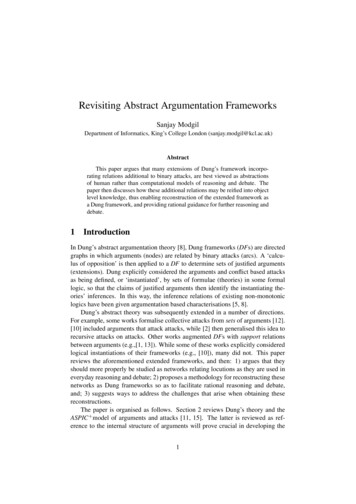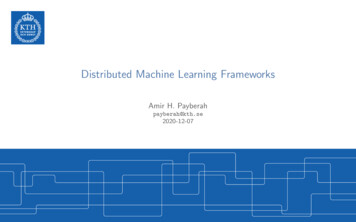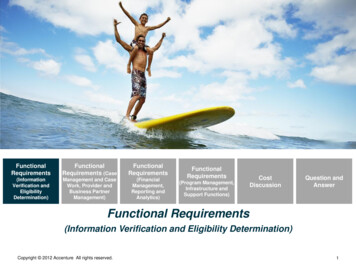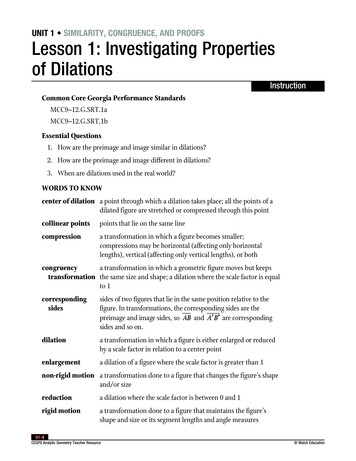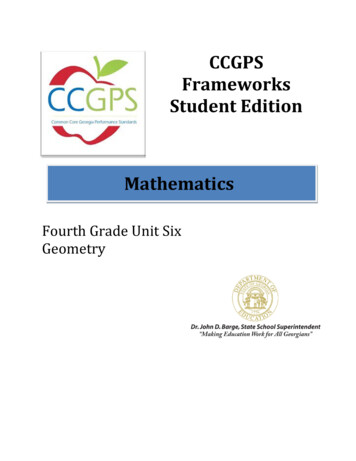
Transcription
CCGPSFrameworksStudent EditionMathematicsFourth Grade Unit SixGeometry
Georgia Department of EducationCommon Core Georgia Performance Standards FrameworkFourth Grade Mathematics Unit 6Unit 6: GEOMETRYTABLE OF CONTENTSOverview .3Standards For Mathematical Content.4Standards For Mathematical Practice .5Enduring Understandings.5Essential Questions .5Concepts & Skills to Maintain .6Selected Terms and Symbols .6Strategies for Teaching and Learning .7Evidence of Learning .8Tasks .9 What Makes a Shape? .10 Angle Shape Sort .14 Is This the Right Angle? .20 Be an Expert .24 Thoughts About Triangles .30 My Many Triangles.37 Quadrilateral Roundup .43 Superhero Symmetry .51 Line Symmetry.55 A Quilt of Symmetry .64 Decoding ABC Symmetry .68Culminating TaskGeometry Town .73MATHEMATICS GRADE 4 UNIT 6: GeometryGeorgia Department of EducationDr. John D. Barge, State School SuperintendentMay 2012 Page 2 of 76All Rights Reserved
Georgia Department of EducationCommon Core Georgia Performance Standards FrameworkFourth Grade Mathematics Unit 6OVERVIEWDraw and identify lines and angles, and classify shapes by properties of their lines and angles.In this unit students will: Draw points, lines, line segments, rays, angles (right, acute, obtuse), and perpendicularand parallel lines Identify and classify angles and identify them in two-dimensional figures Distinguish between parallel and perpendicular lines and use them in geometric figures Identify differences and similarities among two dimensional figures based on theabsence or presence of characteristics such as parallel or perpendicular lines and anglesof a specified size Sort objects based on parallelism, perpendicularity, and angle types Recognize a right triangle as a category for classification Identify lines of symmetry and classify line-symmetric figures Draw lines of symmetryAlthough the units in this instructional framework emphasize key standards and big ideas atspecific times of the year, routine topics such as estimation, mental computation, and basiccomputation facts should be addressed on an ongoing basis. Ideas related to the eight standards ofmathematical practice: making sense of problems and persevering in solving them, reasoningabstractly and quantitatively, constructing viable arguments and critiquing the reasoning of others,modeling mathematics, using appropriate tools strategically, attending to precision, looking for andmaking use of structure, and looking for and expressing regularity in repeated reasoning, should beaddressed continually as well. The first unit should establish these routines, allowing students togradually enhance their understanding of the concept of number and to develop computationalproficiency.Critical Areas are designed to bring focus to the standards at each grade by describing the bigideas that educators can use to build their curriculum and to guide instruction. Students describe,analyze, compare, and classify two-dimensional shapes. Through building, drawing, and analyzingtwo-dimensional shapes, students deepen their understanding of properties of two-dimensionalobjects and the use of them to solve problems involving symmetry.VAN HIELE LEVELS OF GEOMETRIC THINKINGHow students view and think about geometric ideas can vary greatly based on their pastexperiences. In order to set students up for success in geometry and to develop their ability to thinkand reason in geometric contexts, it is important to understand what research has to say about howstudents develop their understanding of geometric concepts.According to the van Hiele Levels of Geometric Thought, there is a five-level hierarchy ofgeometric thinking. These levels focus on how students think about geometric ideas rather thanfocusing solely on geometric knowledge that they hold.MATHEMATICS GRADE 4 UNIT 6: GeometryGeorgia Department of EducationDr. John D. Barge, State School SuperintendentMay 2012 Page 3 of 76All Rights Reserved
Georgia Department of EducationCommon Core Georgia Performance Standards FrameworkFourth Grade Mathematics Unit 6Van Hiele Levels of Geometric Thought, Summarized(taken from Teaching Student-Centered Mathematics: 3-5, by John Van de Walle and Lou Ann Lovin)Level 0: VisualLevel 1: AnalysisLevel 2: Informal DeductionLevel 3: DeductionLevel 4: RigorStudents use visual clues to identify shapes. The objects of thought at level 0 are shapes andwhat they “look like.” The appearance of the shape defines the shape A square is a square because it “looks like asquare.” The products of thought at level 0 are classes orgroupings of shapes that seem “alike.”Students create classes of shapes. The objects of thought at level 1 are classes ofshapes rather than individual shapes. Instead of talking about this rectangle, it is possibleto talk about all rectangles. All shapes within a class hold the same properties. The products of thought at level 1 are the propertiesof shapes.Students use properties to justify classifications of shapesand categorize shapes. The objects of thought at level 2 are the propertiesof shapes. Relationships between and among properties aremade. “If all four angles are right angles, the shape mustbe a rectangle. If it is a square, all angles are rightangles. If it is a square, it must be a rectangle.” The products of thought at level 2 are relationshipsamong properties of geometric objects.Students form formal proofs and theorems about shapes. This is the traditional level of a high schoolgeometry course.Students focus on axioms rather than just deductions. This is generally the level of a college mathematicsmajor who studies geometry as a mathematicalscience.STANDARDS FOR MATHEMATICAL CONTENT4.G Draw and identify lines and angles, and classify shapes by properties of their lines andangles.MCC. 4.G.1 Draw points, lines, line segments, rays, angles (right, acute, obtuse), andperpendicular and parallel lines. Identify these in two-dimensional figures.MATHEMATICS GRADE 4 UNIT 6: GeometryGeorgia Department of EducationDr. John D. Barge, State School SuperintendentMay 2012 Page 4 of 76All Rights Reserved
Georgia Department of EducationCommon Core Georgia Performance Standards FrameworkFourth Grade Mathematics Unit 6MCC.4.G.2 Classify two-dimensional figures based on the presence or absence of parallel orperpendicular lines, or the presence or absence of angles of a specified size. Recognize righttriangles as a category, and identify right triangles.MCC.4.G.3 Recognize a line of symmetry for a two-dimensional figure as a line across the figuresuch that the figure can be folded along the line into matching parts. Identify line-symmetric figuresand draw lines of symmetry.STANDARDS FOR MATHEMATICAL PRACTICE1. Make sense of problems and persevere in solving them.2. Reason abstractly and quantitatively.3. Construct viable arguments and critique the reasoning of others.4. Model with mathematics.5. Use appropriate tools strategically.6. Attend to precision.7. Look for and make use of structure.8. Look for and express regularity in repeated reasoning.***Mathematical Practices 1 and 6 should be evident in EVERY lesson***ENDURING UNDERSTANDINGS Geometric figures can be analyzed based on their properties.Geometric figures can be classified based on their properties.Parallel sides, particular angle measures, and symmetry can be used to classify geometricfigures.Two lines are parallel if they never intersect and are always equidistant.Two lines are perpendicular if they intersect in right angles (90º).Lines of symmetry for a two-dimensional figure occur when a line can be drawn across thefigure such that the figure can be folded along the line into matching parts.ESSENTIAL QUESTIONS How are geometric objects different from one another?How are quadrilaterals alike and different?How are symmetrical figures created?How are symmetrical figures used in artwork?How are triangles alike and different?How can angle and side measures help us to create and classify triangles?How can shapes be classified by their angles and lines?How can the types of sides be used to classify quadrilaterals?How can triangles be classified by the measure of their angles?How can we sort two-dimensional figures by their angles?MATHEMATICS GRADE 4 UNIT 6: GeometryGeorgia Department of EducationDr. John D. Barge, State School SuperintendentMay 2012 Page 5 of 76All Rights Reserved
Georgia Department of EducationCommon Core Georgia Performance Standards FrameworkFourth Grade Mathematics Unit 6 How can you create different types of quadrilaterals?How can you create different types of triangles?How can you determine the lines of symmetry in a figure?How can you use only a right angle to classify all angles?How do you determine lines of symmetry? What do they tell us?How is symmetry used in areas such as architecture and art? In what areas is symmetryimportant?What are the geometric objects that make up figures?What are the mathematical conventions and symbols for the geometric objects that make upcertain figures?What are the properties of quadrilaterals?What are the properties of triangles?What are triangles?What is a quadrilateral?What is symmetry?What makes an angle a right angle?What properties do geometric objects have in common?Where is geometry found in your everyday world?Which letters of the alphabet are symmetrical?CONCEPTS/SKILLS TO MAINTAINIt is expected that students will have prior knowledge/experience related to the concepts and skillsidentified below. It may be necessary to pre-assess in order to determine if time needs to be spenton conceptual activities that help students develop a deeper understanding of these ideas. Identify shapes as two-dimensional or three- dimensional Analyze and compare two- and three-dimensional shapes, in different sizes and orientations,using informal language to describe their similarities, differences, parts Compose simple shapes to form larger shapes Compose two-dimensional shapes or three-dimensional shapes to create a composite shape Partition circles and rectangles into two, three, ad four equal shares Recognize and draw shapes having specified attributes such as a given number of angles ora given number of equal faces Identify triangles, quadrilaterals, pentagons, hexagons, and cubes Partition a rectangle into rows and columns Understand that shapes in different categories may share attributes and that the sharedattributes can define a larger category Recognize rhombuses, rectangles, and squares as examples of quadrilaterals Draw examples of quadrilaterals that are not rhombuses, rectangles, and squares Partition shapes into parts with equal areasMATHEMATICS GRADE 4 UNIT 6: GeometryGeorgia Department of EducationDr. John D. Barge, State School SuperintendentMay 2012 Page 6 of 76All Rights Reserved
Georgia Department of EducationCommon Core Georgia Performance Standards FrameworkFourth Grade Mathematics Unit 6SELECTED TERMS AND SYMBOLSThe following terms and symbols are often misunderstood. These concepts are not an inclusivelist and should not be taught in isolation. However, due to evidence of frequent difficulty andmisunderstanding associated with these concepts, instructors should pay particular attention to themand how their students are able to explain and apply them.Teachers should present these concepts to students with models and real life examples.Students should understand the concepts involved and be able to recognize and/or demonstratethem with words, models, pictures, or numbers.The websites below are interactive and include a math glossary suitable for elementary children.It has activities to help students more fully understand and retain new vocabulary. (i.e. Thedefinition for dice actually generates rolls of the dice and gives students an opportunity to addthem.) Note – At the elementary level, different sources use different definitions. Pleasepreview any website for alignment to the ary/The terms below are for teacher reference only and are not to be memorized by the students. acute angle angle equilateral triangle isosceles triangle line of symmetry obtuse angle parallel lines parallelogram perpendicular lines plane figure polygon quadrilateral rectangle rhombus right angle. scalene triangle side square symmetry triangle trapezoid vertex (of a 2-D figure)MATHEMATICS GRADE 4 UNIT 6: GeometryGeorgia Department of EducationDr. John D. Barge, State School SuperintendentMay 2012 Page 7 of 76All Rights Reserved
Georgia Department of EducationCommon Core Georgia Performance Standards FrameworkFourth Grade Mathematics Unit 6STRATEGIES FOR TEACHING AND LEARNINGAnglesStudents can use the corner of a sheet of paper as a benchmark for a right angle. They can use aright angle to determine relationships of other angles.SymmetryWhen introducing line of symmetry, provide examples of geometric shapes with and without linesof symmetry. Shapes can be classified by the existence of lines of symmetry in sorting activities.This can be done informally by folding paper, tracing, creating designs with tiles or investigatingreflections in mirrors.With the use of a dynamic geometric program, students can easily construct points, lines andgeometric figures. They can also draw lines perpendicular or parallel to other line segments.Two-dimensional shapesTwo-dimensional shapes are classified based on relationships by the angles and sides. Students candetermine if the sides are parallel or perpendicular, and classify accordingly. Characteristics ofrectangles (including squares) are used to develop the concept of parallel and perpendicular lines.The characteristics and understanding of parallel and perpendicular lines are used to drawrectangles. Repeated experiences in comparing and contrasting shapes enable students to gain adeeper understanding about shapes and their properties.Informal understanding of the characteristics of triangles is developed through angle measures andside length relationships. Triangles are named according to their angle measures (right, acute orobtuse) and side lengths (scalene, isosceles or equilateral). These characteristics are used to drawtriangles.EVIDENCE OF LEARNINGBy the conclusion of this unit, students should be able to demonstrate the following competencies: Draw points, lines, line segments, rays, angles (right, acute, obtuse) and perpendicularand parallel lines Identify points, lines, line segments, rays, angles (right, acute, obtuse) and perpendicularand parallel lines in two-dimensional figures Classify two-dimensional figures based on the absence or presence of parallel orperpendicular lines Classify two-dimensional figures based on the absence or presence of angles of aspecified size Recognize right triangles as a category Identify right triangles Recognize a line of symmetry for a two-dimensional figure Identify lines-symmetric figures Draw lines of symmetryMATHEMATICS GRADE 4 UNIT 6: GeometryGeorgia Department of EducationDr. John D. Barge, State School SuperintendentMay 2012 Page 8 of 76All Rights Reserved
Georgia Department of EducationCommon Core Georgia Performance Standards FrameworkFourth Grade Mathematics Unit 6TASKSThe following tasks represent the level of depth, rigor, and complexity expected of all fourthgrade students. These tasks or tasks of similar depth and rigor should be used to demonstrateevidence of learning. It is important that all elements of a task be addressed throughout the learningprocess so that students understand what is expected of them. While some tasks are identified as aperformance task, they also may be used for teaching and learning.Scaffolding TaskConstructing TaskPractice TaskPerformance TasksTasks that build up to Constructing understanding Games/activitiesSummative assessment forthe constructing task. through deep/richthe unitcontextualized problemsolving tasksTask NameTask TypeGrouping StrategyContent AddressedScaffolding TaskPartners/GroupsPractice TaskPartnersPractice TaskLarge Group/IndividualLearning conventions for the partsof a shapeBe an ExpertPractice TaskPartners/GroupsRefine/extend understanding ofgeometric objectsThoughts About TrianglesConstructing TaskPartners/GroupsInvestigate and explain properties oftrianglesMy Many TrianglesPractice TaskIndividual/PartnerClassify triangles by their anglesand lengths of sideQuadrilateral RoundupConstructing TaskPartners/GroupsInvestigate and explain theproperties of quadrilateralsSuperhero SymmetryScaffolding TaskPartnersExplore the meaning of symmetryand symmetrical figuresLine SymmetryConstructing TaskPartner/GroupsExplore the meaning of symmetryand symmetrical figuresWhat Makes a Shape?Angle Shape SortIs This the Right Angle?A Quilt of SymmetryDecoding ABC SymmetryGeometry TownConstructing TaskIndividual/PartnersPractice TaskIndividual/PartnersCulminating TaskIndividuals/PartnersSorting shapes by anglesComparing anglesUsing symmetry to design a quiltFinding lines of symmetry in thealphabetUsing geometry knowledge todesign a town of certainspecificationsMATHEMATICS GRADE 4 UNIT 6: GeometryGeorgia Department of EducationDr. John D. Barge, State School SuperintendentMay 2012 Page 9 of 76All Rights Reserved
Georgia Department of EducationCommon Core Georgia Performance Standards FrameworkFourth Grade Mathematics Unit 6Scaffolding Task: What Makes a Shape?STANDARDS FOR MATHEMATICAL CONTENTMCC. 4.G.1 Draw points, lines, line segments, rays, angles (right, acute, obtuse), andperpendicular and parallel lines. Identify these in two-dimensional figures.STANDARDS FOR MATHEMATICAL PRACTICE1.2.3.4.5.6.7.8.Make sense of problems and persevere in solving them.Reason abstractly and quantitatively.Construct viable arguments and critique the reasoning of others.Model with mathematics.Use appropriate tools strategically.Attend to precision.Look for and make use of structure.Look for and express regularity in repeated reasoning.BACKGROUND KNOWLEDGEAs students begin their explorations of geometric figures and their properties, it is important tomake sure that students have some common vocabulary. This lesson can be used at the onset of theunit to introduce and teach students conventions for notating certain properties of figures or it canbe used throughout the unit as these different properties come up. You should keep an anchor chartclearly displayed in your classroom for the geometric terms that come up throughout the unit, aswell as the mathematical conventions/symbols that are used to represent those geometric objects.Ideally, we want students to have a purpose or need for these conventions before introducingthem. This means that these terms must be explored in context by students in order for that need toexist. This task can serve as a context for helping to develop that common vocabulary andmathematical notation at the onset of the Geometry unit. Many of these geometric objects and partswill be developed in depth later in the unit. You may choose to wait until they are developed toprovide the conventional notation to students.ESSENTIAL QUESTIONS What are the geometric objects that make up figures?What are the mathematical conventions and symbols for the geometric objects that make upcertain figures?MATERIALS “Sorting Shapes” for each groupMath journals/notebooksMATHEMATICS GRADE 4 UNIT 6: GeometryGeorgia Department of EducationDr. John D. Barge, State School SuperintendentMay 2012 Page 10 of 76All Rights Reserved
Georgia Department of EducationCommon Core Georgia Performance Standards FrameworkFourth Grade Mathematics Unit 6GROUPINGSmall group taskTASK DESCRIPTION, DEVELOPMENT, AND DISCUSSIONTask DirectionsStudents will sort the “Sorting Shapes” cards based on any attributes they choose. Have themshare and discuss their sorts, highlighting the key vocabulary they use to describe their sorts(angles, number of sides) as students discuss these various parts and properties of the angles thatthey already know. Make sure they can answer the following questions. How did you group your shapes? What makes a shape a shape? What are the parts of a shape? How can you tell the differences between shapes?Use this as a launching point for discussing the geometric objects listed below and theirconventional notation. This would be a time to discuss the differences between lines, line segments,and rays. As students discuss these geometric objects, have them record the conventions that youare recording on an anchor chart into their math journal for reference throughout the unit. You maywish to show the notations below in several orientations. For instance, showing multipleorientations of a right angle (where one side of the angle is NOT parallel to the bottom of the paper)MATHEMATICS GRADE 4 UNIT 6: GeometryGeorgia Department of EducationDr. John D. Barge, State School SuperintendentMay 2012 Page 11 of 76All Rights Reserved
Georgia Department of EducationCommon Core Georgia Performance Standards FrameworkFourth Grade Mathematics Unit 6FORMATIVE ASSESMSENT QUESTIONS What characteristics did you use to group your shapes?What are the geometric objects used to form various figures?Where do you see your geometric objects in the real world?Can students consider more than one attribute at a time?Can students justify the placement of the shapes in their groups?Are students able to recognize the difference between essential and non-essential propertiesof geometric object?DIFFERENTIATIONExtension Have students identify the geometric objects discussed in various shapes and recordthis in their journals.Intervention Have students use Wiki sticks or pieces of straw to create different shapes. Havethem label the parts of the shape (line segments, points, etc.) and then mark theseusing the mathematical convention.MATHEMATICS GRADE 4 UNIT 6: GeometryGeorgia Department of EducationDr. John D. Barge, State School SuperintendentMay 2012 Page 12 of 76All Rights Reserved
Georgia Department of EducationCommon Core Georgia Performance Standards FrameworkFourth Grade Mathematics Unit 6Sorting ShapesMATHEMATICS GRADE 4 UNIT 6: GeometryGeorgia Department of EducationDr. John D. Barge, State School SuperintendentMay 2012 Page 13 of 76All Rights Reserved
Georgia Department of EducationCommon Core Georgia Performance Standards FrameworkFourth Grade Mathematics Unit 6Practice Task: Angle Shape SortSTANDARDS FOR MATHEMATICAL CONTENTMCC. 4.G.1 Draw points, lines, line segments, rays, angles (right, acute, obtuse), andperpendicular and parallel lines. Identify these in two-dimensional figures.STANDARDS FOR MATHEMATICAL PRACTICE1.2.3.4.5.6.7.8.Make sense of problems and persevere in solving them.Reason abstractly and quantitatively.Construct viable arguments and critique the reasoning of others.Model with mathematics.Use appropriate tools strategically.Attend to precision.Look for and make use of structure.Look for and express regularity in repeated reasoning.BACKGROUND KNOWLEDGEStudents should have had prior experiences and/or instruction with plane figures and angles.A common misconception that many students have is that wide angles with short sides may seemsmaller than a narrow angle with long sides. Students can compare two angles by tracing one andplacing it over another. Students will then realize that the length of the sides does not determinewhether one angle is larger or smaller than another angle. The measure of the angle is notdependent on the lengths of the legs.ESSENTIAL QUESTIONS How can we sort two-dimensional figures by their angles?MATERIALS 3 bendable straws/Wikki Sticks/Pipe Cleaners per studentPaper shape cutoutsAngle sorting student task sheetGROUPINGPartnersMATHEMATICS GRADE 4 UNIT 6: GeometryGeorgia Department of EducationDr. John D. Barge, State School SuperintendentMay 2012 Page 14 of 76All Rights Reserved
Georgia Department of EducationCommon Core Georgia Performance Standards FrameworkFourth Grade Mathematics Unit 6TASK DESCRIPTION, DEVELOPMENT, AND DISCUSSIONPart ITell students that today you will learn about something called angles. Remind students that an angleis formed when two lines or sides share a vertex. Show students several angles on the board. Askstudents to look for angles throughout the room. After students have found several angles, tellstudents that there are three types of angles that we will discuss this year: acute, obtuse, and right.Show students how sometimes you can create angles through different parts of your body, like yourarms or your ankles. Show students a 90o angle with your ankle. Tell students that this is called aright angle. Next, show them an acute angle by pulling your toes up toward your shin. Last, showthem an obtuse angle by pointing your toes and stretching them away from your shin. Allow thestudents to try showing the angles with their ankles as you say the words “right angle”, acuteangle”, or “obtuse angle”. You can also do this with your arms. Have them make a strong bicep“muscle” to demonstrate a right angle. Then draw your fist closer to your shoulder to create anacute angle and extend your forearm moving the fist away from the shoulder to create an obtuseangle. Ask the students if the length of their foot or leg changes the size of the angle. How aboutthe length of the arm? Why or why not? Talk with the students about the fact that an anglerepresents the size of the opening between your foot and leg or your upper and lower arm.Part IIReview the three types of angles with students. Give each student three bendable straws, WikkiSticks, or pipe cleaners. Have students use the material to form each type of angle (acute, obtuse, orright). Have them show their angles to a partner to check. Then give each set of partners a set ofsticks (coffee stirrers etc.) and ask them to play “pick up” sticks. Students will gather a fist full ofstraws and then carefully drop them from a kneeling position. Once all sticks have dropped, theyshould locate angles. The teacher should circulate and ask students to identify angles they found.This game time should only last a few minutes.Part IIIGive each student a sorting sheet and shape handout. Have students cut out each of the shapes.Then, give each student two straws/Wikki-sticks/pipe cleaners. Students can measure one strawusing the corner of their paper and tape it at a 90 degree angle. Students can then manipulate theother straw to match the angles of each shape. Another option is to use an index card to locate aright angle. Next, they can compare the manipulated straw to the right angle straw to determine ifthe angle is right, obtuse, or acute. After measuring, encourage students to draw the shape in thecorrect section of the chart.While students are working, ask questions like: What shape are you working with? How did you know its name? How many angles does your shape have? What types of angles does your shape have? How did you figure that out? Where will you place your shape on the chart?MATHEMATICS GRADE 4 UNIT 6: GeometryGeorgia Department of EducationDr. John D. Barge, State School SuperintendentMay 2012 Page 15 of 76All Rights Reserved
Georgia Department of EducationCommon Core Georgia Performance Standards FrameworkFourth Grade Mathematics Unit 6 Did you have to use the straws each time? If not, how did you determine what theangle was?Part IVHave students come together to share the placement of each of the shapes. The teacher shouldprepare larger versions of each shape and the sorting sheet. Allow partner groups to place theshapes in the correct sections. Students should justify the placement of each shape byexp
Georgia Department of Education Common Core Georgia Performance Standards Framework Fourth Grade Mathematics Unit 6 MATHEMATICS GRADE 4 UNIT 6: Geometry


